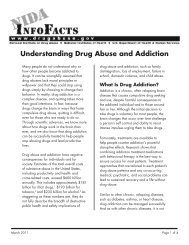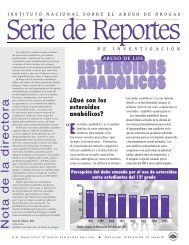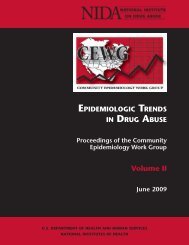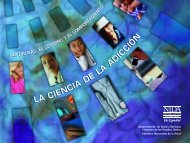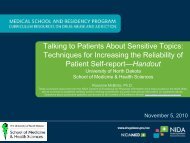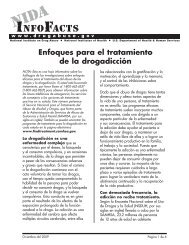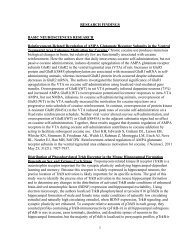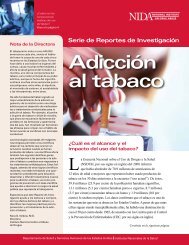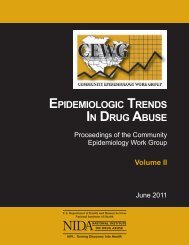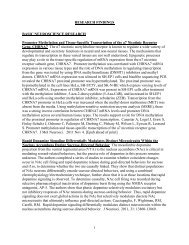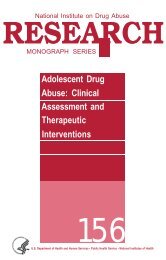CEWG January 09 Full Report - National Institute on Drug Abuse
CEWG January 09 Full Report - National Institute on Drug Abuse
CEWG January 09 Full Report - National Institute on Drug Abuse
Create successful ePaper yourself
Turn your PDF publications into a flip-book with our unique Google optimized e-Paper software.
EpidEmiologic TrEnds in drug AbusE: HigHligHTs And ExEcuTivE summAry<br />
Interval, or CI:1.5,5.1) in 2005 and 2.3 percent<br />
(CI:1.6,3.4) in 2007. Two types of heroin were<br />
available—Mexican black tar coming to the regi<strong>on</strong><br />
from the Southwest and more recently, South<br />
American (SA) heroin. Increased involvement of<br />
Mexican dealers has complicated the market. Heroin<br />
Domestic M<strong>on</strong>itor Program (HDMP) analyses<br />
in 2007 reflected this growing, competitive<br />
heroin market in the St. Louis area, with decreasing<br />
purity in black tar heroin and increasing purity<br />
in the SA heroin. South American and Mexican<br />
black tar were represented in the samples, with<br />
more white samples than black tar samples. Indicators<br />
for opiates have increased for both heroin<br />
and other opiates. This increase is c<strong>on</strong>sistent with<br />
reported availability for heroin and reports from<br />
rural law enforcement about increased usage. The<br />
available indicators for other opiates remained<br />
stable for this reporting period, after a significant<br />
increase in reports between 2006 and 2007 in the<br />
St. Louis area. While the actual number of admissi<strong>on</strong>s<br />
was relatively low, there is still reas<strong>on</strong> for<br />
c<strong>on</strong>cern, as anecdotal informati<strong>on</strong> has indicated<br />
that abuse of narcotic analgesics has been <strong>on</strong> the<br />
rise in this regi<strong>on</strong>, al<strong>on</strong>g with c<strong>on</strong>cern about rural<br />
use of prescripti<strong>on</strong> narcotics. Marijuana was c<strong>on</strong>sidered<br />
stable or possibly growing slightly in the<br />
regi<strong>on</strong>. While treatment admissi<strong>on</strong>s dropped 7.3<br />
percent from 2006 to 2007, they rose again in the<br />
first half of 2008. However, these admissi<strong>on</strong>s may<br />
be in resp<strong>on</strong>se to criminal justice demands. The<br />
percentage of current users in the YRBS shows no<br />
change since the 2005 survey. Cannabis was the<br />
most frequently cited substance identified in the<br />
2007 and <str<strong>on</strong>g>January</str<strong>on</strong>g>–June 2008 <str<strong>on</strong>g>Nati<strong>on</strong>al</str<strong>on</strong>g> Forensic<br />
Laboratory Informati<strong>on</strong> System (NFLIS) reports<br />
for the St. Louis MSA. Methamphetamine indicators<br />
appeared to be decreasing in for the St.<br />
Louis regi<strong>on</strong>. Treatment admissi<strong>on</strong>s have risen by<br />
30 percent since the sec<strong>on</strong>d half of 2007. YRBS<br />
data suggest that lifetime methamphetamine use<br />
am<strong>on</strong>g students has decreased, from 6.4 percent<br />
(CI:4.4,9.1) in 2005 to 3.7 percent (CI:2.9,4.7)<br />
in 2007. While it is believed that the bulk of the<br />
available methamphetamine is being imported<br />
from Mexico, reports of “ice” from Mexico are<br />
not well-substantiated. One indicati<strong>on</strong> that the<br />
methamphetamine problem is not disappearing<br />
is the large number of positive toxicology screens<br />
am<strong>on</strong>g the Department of Correcti<strong>on</strong>s populati<strong>on</strong><br />
in 2007 and the anecdotal reports from rural<br />
health clinics about patients who are current or<br />
former methamphetamine users. The pseudoephedrine<br />
c<strong>on</strong>trol legislati<strong>on</strong> has led to more<br />
creative ways of networking for the local “cooks”<br />
to gain access to the chemicals needed to make<br />
methamphetamine. Further analysis and m<strong>on</strong>itoring<br />
are needed. Interestingly, the eastern half<br />
of the State remained relatively active in clandestine<br />
laboratory operati<strong>on</strong>s; 108 clandestine laboratories<br />
were reported in a rural county of the<br />
MSA in the first half of 2008 (Jeffers<strong>on</strong> County).<br />
However, clandestine laboratory incidents in the<br />
St. Louis MSA were down from 868 in 2005 to 503<br />
in 2007. Statewide, 770 clandestine laboratories<br />
were reported in the first half of 2008. Prescripti<strong>on</strong><br />
drug abuse has been growing, particularly in<br />
the rural areas. However, it has been diffcult to<br />
access data to substantiate this trend. There have<br />
been multiple reports from key informants about<br />
increases in prescripti<strong>on</strong> drug use and in the<br />
c<strong>on</strong>tinued use of MDMA in select populati<strong>on</strong>s.<br />
HIV/AIDS Update: Data available from the St<br />
Louis City Health Department and the Missouri<br />
Department of Health and Senior Services for<br />
2007 indicate that the risk factor of injecti<strong>on</strong> drug<br />
use does not play a major role in the transmissi<strong>on</strong><br />
of human immunodeficiency virus (HIV) or<br />
acquired immunodeficiency syndrome (AIDS) in<br />
the St. Louis area. However, the men who have<br />
sex with men (MSM) populati<strong>on</strong> and heterosexual<br />
c<strong>on</strong>tact in minority populati<strong>on</strong>s are more<br />
prominent risk factors. The role of alcohol and<br />
other drug use am<strong>on</strong>g these populati<strong>on</strong>s is a key<br />
factor. Emerging Patterns: Indicators for many<br />
substances appeared to be stable. However, the<br />
number of cocaine-related deaths and the increase<br />
in a number of opiate abuse indicators are cause<br />
for c<strong>on</strong>cern and c<strong>on</strong>tinued m<strong>on</strong>itoring. A synthesis<br />
of all data sources leads to the c<strong>on</strong>clusi<strong>on</strong> that<br />
the heroin problem in St. Louis is becoming larger<br />
and more complex, with the market becoming<br />
68<br />
Proceedings of the Community Epidemiology Work Group, <str<strong>on</strong>g>January</str<strong>on</strong>g> 20<str<strong>on</strong>g>09</str<strong>on</strong>g>



